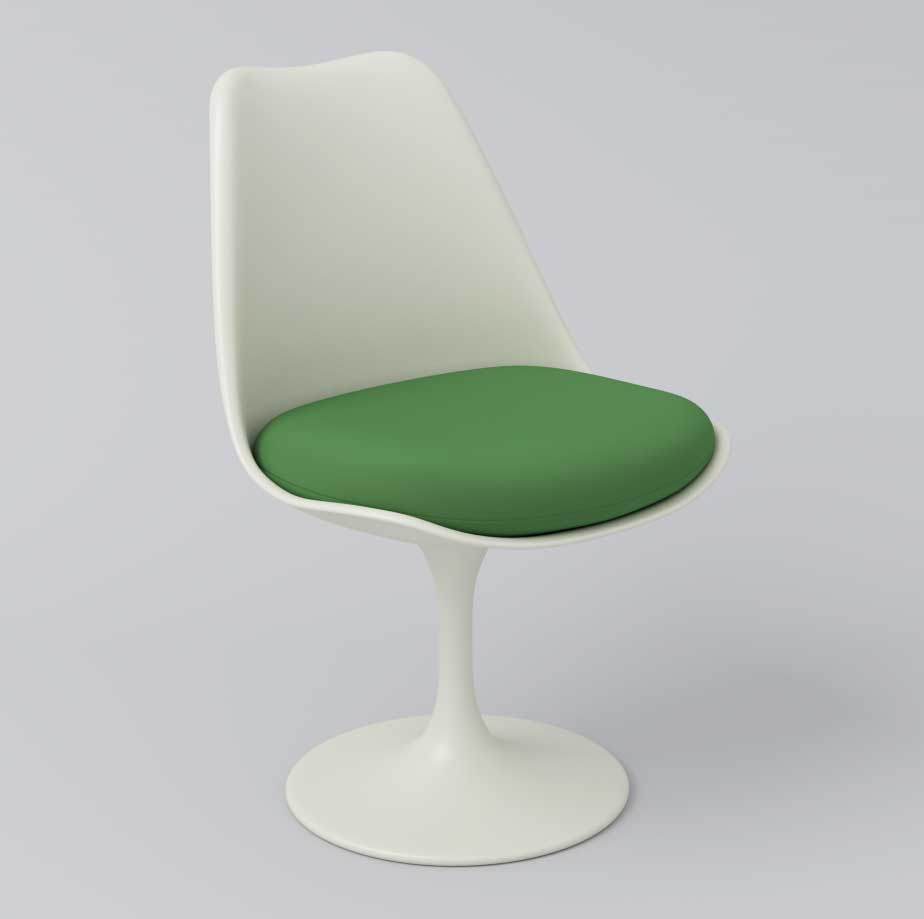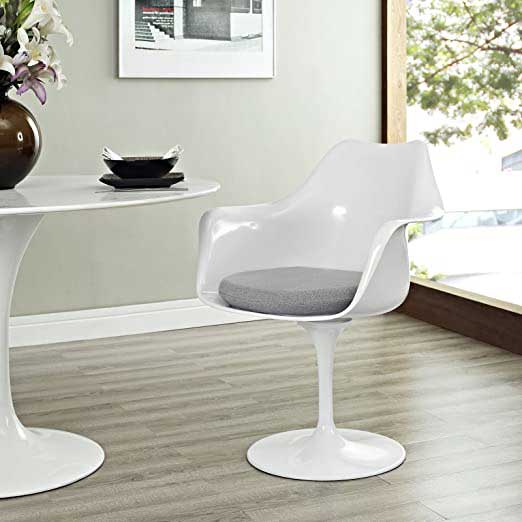Tulip chair and table by Eero Saarinen, a mid century classic
The name
The name of the Tulip chair quite obviously derives from the floral shape of the product. It has been noted by many that the chair more properly resembles a wine glass, especially if you consider the base of the stem.
The design

Eero Saarinen (1910 – 1961) was a Finnish-born American architect best known for his design of the Gateway Arch in St. Louis, the TWA (currently Jet Blue) terminal in New York and two iconic chairs: the Tulip chair and the Womb chair. The design known by the floral name was driven by Saarinen’s desire to address what he believed to be a problem. He famously pointed out the “crowded” space under dining room chair and dining room tables – a slum of legs, as he called it. The Tulip chair and its matching table have only one leg each. While there were many practical ways to achieve this, Saarinen used one the most popular material of the time: fiberglass. This allowed him to create organic flow of slightly reflective surfaces. As far as the architect was concerned, fiberglass was he needed, but early tests demonstrated that this material on its own was not strong enough. The final design, patented in 1960, featured a metal construction hidden underneath the smooth plastic outer layer. The Tulip chair can only mistakenly be called a fiberglass chair.
Later variations in the design
 The original Tulip chair was designed for Knoll and had two variations: with and without armrests. Despite having beeen patented, the design was copied and often modified. Because neither Saarinen’s name nor the word tulip can be used by other manufacturers the often used term is mid-century modern chair To simplify production, there are even multiple versions of the chair which only used the tulip shaped seat, while preserving the traditional undercarriage of four legs, which goes completely against the designer’s initial impetus. Addressing the Tulip chair’s relative lack of comfort, some versions are fully upholstered. The tables are less popular and for obvious reasons they don’t boast a floral appearance and are somewhat less iconic.
The original Tulip chair was designed for Knoll and had two variations: with and without armrests. Despite having beeen patented, the design was copied and often modified. Because neither Saarinen’s name nor the word tulip can be used by other manufacturers the often used term is mid-century modern chair To simplify production, there are even multiple versions of the chair which only used the tulip shaped seat, while preserving the traditional undercarriage of four legs, which goes completely against the designer’s initial impetus. Addressing the Tulip chair’s relative lack of comfort, some versions are fully upholstered. The tables are less popular and for obvious reasons they don’t boast a floral appearance and are somewhat less iconic.
Where to use the Tulip chair
Originally conceived as a dining chair, the Tulip is not always favored for that purpose, being slightly awkward to move. If you recall the familiar of pushing your chair closer towards the table while getting up just enough, this is precisely what becomes a little bit more difficult if you have to deal with the wide base of a Tulip chair. Some models can swivel, so you would be turning yourself towards the table. Apart from this inconvenience, it is important to remember that the full impact of this chair’s beauty is revealed when it is seen unoccupied, facing the viewer. Rows of Tulip chairs tucked around a table just don’t look as impressive. It makes these chairs well suited for reception areas. Just don’t forget that they are not for prolonged seating. Their backs, however contoured, are not upholstered as a rule.
If you want to get a fair idea of how Tulip chairs “behave” in an interior, you are advised to watch an episode of the original Star Trek series. The modern, space age appearance of this product made it a logical choice for set designers.
Where to buy Tulip chair and tables
If you want to get authentic Tulip chairs and tables the only option is to buy them from Knoll. Each chair will cost you just under $2,000 and the price of the table is about $2,500. Imitation chairs and tables are vastly less expensive. Keep in mind that Knoll Pedestal Collection furniture has better resale value. Original chairs from the 1950s are considered collectable. The 50 year anniversary chairs have quickly reached the same status.
One more thing to remember. Despite bearing some resemblance to modern office chairs, the classic Tulip chair is not height-adjustable. You have to make sure that the chairs and the table (if you are buying one) work well together. Buy them from the same source. If you are buying the armrest variety, be sure that the chair can go underneath the surface of the table.